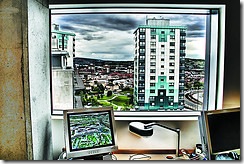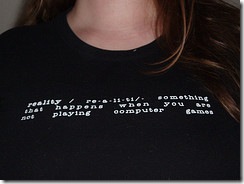Visual reality has much to do, not only with the real physical disposition of the world or scene, but also with how it is perceived. Someone with color blindness or some other visual impairment will have a different perception of reality than someone who’s vision is considered normal.
In photography, even if we assume that all film stocks and all digital sensors would capture light the same way, the simple fact that different lenses distort to a certain degree the light, is enough to conclude that photography cannot capture reality, but simply capture light.
What started me thinking…
A few days ago, I was reading a report mentioning how a Danish photographer saw his work disqualified from the Danish version of the “Pictures of the Year†contest. In short, the photojournalist got disqualified when judges requested his RAW files for comparison with the submitted processed images. Although the contest rules mention that "Photos submitted to Picture of The Year must be a truthful representation of whatever happened in front of the camera during exposure. You may post-process the images electronically in accordance with good practice. That is cropping, burning, dodging, converting to black and white as well as normal exposure and color correction, which preserves the image’s original expression.â€, it seems that this photojournalist’s processing was too much for the judges.
I’ve passed this story to my twitter followers and this generated a nice discussion, with @marcoschmidt replying “but what’s real? the JPG? with which picture style? the RAW? With which converter? black and white?â€
Capturing reality in photojournalism
 I firmly believe that if what a photographer is doing is photojournalism, then the final images should indeed resemble as much as possible the original scene notwithstanding any different interpretations that may arise from framing, composition, etc. If too many exceptions are allowed, photojournalism will turn into a field of doubt and many publications have, indeed, strict rules on what is allowed in processing. But asking for the RAW files?!? I’m not sure I agree with this move. If a photographer messes his exposures and ends up with a RAW that is overexposed, does that mean that the original scene was flooded by light? What if the white balance was not properly set? RAW files are exactly that, the raw information. Even a RAW file, outputted with different converters will originate slightly different images. Note that I’m not defending the photojournalist. I believe that what he saw in those places was probably much close to the unmodified RAW than to the images he submitted for the contest and he tried to make them more appealing. But when documenting something, the appeal should come from the story that photos are trying to tell, from good composition, good lighting, good angles… not from Photoshop. Individual ethics play a major role in photojournalism and I still prefer to believe that photojournalism tries to capture reality.
I firmly believe that if what a photographer is doing is photojournalism, then the final images should indeed resemble as much as possible the original scene notwithstanding any different interpretations that may arise from framing, composition, etc. If too many exceptions are allowed, photojournalism will turn into a field of doubt and many publications have, indeed, strict rules on what is allowed in processing. But asking for the RAW files?!? I’m not sure I agree with this move. If a photographer messes his exposures and ends up with a RAW that is overexposed, does that mean that the original scene was flooded by light? What if the white balance was not properly set? RAW files are exactly that, the raw information. Even a RAW file, outputted with different converters will originate slightly different images. Note that I’m not defending the photojournalist. I believe that what he saw in those places was probably much close to the unmodified RAW than to the images he submitted for the contest and he tried to make them more appealing. But when documenting something, the appeal should come from the story that photos are trying to tell, from good composition, good lighting, good angles… not from Photoshop. Individual ethics play a major role in photojournalism and I still prefer to believe that photojournalism tries to capture reality.
Photography as an art form
If we look at photography from an artistic point of view, then all of the above does not apply. Photography becomes a tool to express the photographer’s creativity, and it’s up to each individual artist to modify it (or not) as he pleases, in order to pass to an audience (or at least try to) the story he’s trying to tell and elicit emotions. Nobody asked Dalà if he actually saw that somewhere when he painted “The Railway Station at Perpignan†(one of my favorite works by SD). I can have my personal preferences regarding a certain photographic work or a certain style of photographing or processing, I might like it or not, but no artistic photographer should ever listen that his work is bad because it doesn’t resemble reality.
Photography is not supposed to capture reality, just to capture light.
Twitter me this…
Earlier I asked on Twitter “In 140 chars or less answer this: "Is photography just supposed to capture reality?"
These are some of the replies I got… Interpret and take your own conclusions. Thanks for your thoughts.
@jeffcrossphoto “I think photography is supposed to be an interpretation of reality from the photographer’s point of view.â€
@danzphoto “Absolutely not. Did Monet only try to capture reality? Like him, photography also captures mood, feeling, impression.â€
 @dawilson “Documentary photography is supposed to capture reality as closely as possible given equipment capabilities. / Art photography uses reality as a starting point. What the photographer/artist does with that is entirely up to them.†(Dave cheated and used 2 tweets… That’s ok Dave
@dawilson “Documentary photography is supposed to capture reality as closely as possible given equipment capabilities. / Art photography uses reality as a starting point. What the photographer/artist does with that is entirely up to them.†(Dave cheated and used 2 tweets… That’s ok Dave ![]() )
)
@dwterry “Photography is a tool. It can reflect or augment reality. It can create works of art. It’s all in what you do with it.â€
@pawoli “each photo is real, photographers and viewers have their own realities which may differ and evolve over timeâ€
@EricBooth “By no means. IMO photography is an art form. An expression of ones self. I have no problem using all the tools available to me.â€
@Raquita “Just capture reality limits its power, I think photographs should live up to the 1000 words thing – tell stories beautifully…â€
@Celippitt “Photojournalism is supposed to capture reality…Photography is the process of producing images on photosensitive surfaces.â€
@mcgraths “Photography is an art. I think it should be a blend on imagination and reality, but really it is up to the artist.â€
Your thoughts?
And how do you mix photography with reality? Should it capture just reality or is it, a tool to be used? Share your thoughts with us…
Photo credits: “reality tag†by Scoobymoo (CC by-nd), “sheffield: what’s your reality?†by paolo mà rgari (CC by-nc-nd), “Reality†by Bright Meadow (CC by-sa)

jeremy north
May 25, 2009 at 8:41 pm
As a film photographer my images are what is captured by the emulsion.
Image manipulation is a matter of taste (or more likely, lack thereof). I imagine that in the future people will get over the novelty of what photoshop can do, and that the true art of photography will once again be about the moment.